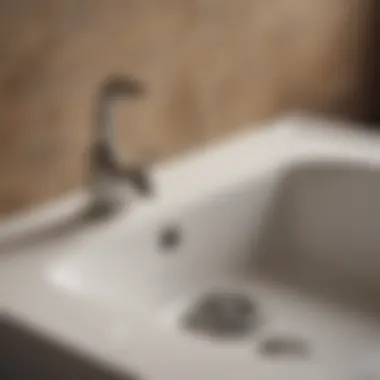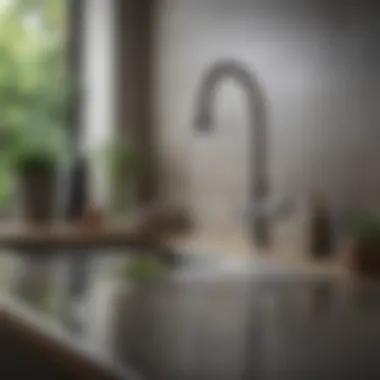Mastering the Art of Cleaning a Blocked Sink Drain


Intro
A blocked sink drain is an issue that every homeowner faces at some point. It is annoying and can lead to more significant problems if not handled promptly. Understanding how to effectively tackle this issue can save you time, money, and maintain your home's functionality. This article explores various methods to clean a blocked sink drain and highlights essential tools and preventive measures to ensure optimal drainage moving forward.
In the following sections, we will examine practical cleaning techniques. We will also cover necessary tools that make this task achievable for anyone, regardless of their skill level. Additionally, understanding why drains become blocked in the first place can significantly enhance your cleaning efforts. Let's begin with an overview of home features that interact with plumbing.
Home Features
Importance of Drainage Systems
Residential plumbing is more than just visible pipes and faucets. The design and layout of your home influence how effective your drainage system is. A well-designed home optimizes the flow of water, minimizing the chances of blockages. Awareness of this can aid homeowners in maintaining their plumbing.
Common Drain Issues
Several features can contribute to blocked sink drains:
- Design Complexity: Homes with intricate designs may have twists and turns in plumbing, making clogs more likely.
- Material Quality: Cheap plumbing materials can deteriorate, causing blockages over time.
- Fittings and Connectors: Poorly installed connectors can trap debris more easily.
Cleaning Techniques
When faced with a blocked drain, there are several approaches to consider. Each method has its advantages and practical applications.
Boiling Water Method
One straightforward technique is pouring boiling water down the drain. This often works well for minor clogs, especially those caused by grease buildup. Repeat this process if necessary, but avoid it with PVC pipes, as it may cause damage.
Baking Soda and Vinegar
A natural alternative involves using baking soda and vinegar. This combination creates a chemical reaction that helps break down grime and debris.
- Pour half a cup of baking soda down the drain.
- Follow it with half a cup of vinegar.
- Cover the drain for about 30 minutes.
- Flush with hot water.
This method is eco-friendly and generally effective for light blockages.
Plumber’s Snake
For persistent blockages, a plumber’s snake is a useful tool. It allows you to reach deep into pipes, dislodging clogs that other methods cannot. Care must be taken to avoid scratches or damage to the interior of the pipes.
Chemical Drain Cleaners
While chemical cleaners are widely available, they should be used sparingly. They can cause more harm than good, especially with older plumbing systems. If you must use them, follow the instructions carefully and consider wearing gloves for safety.
Preventive Measures
Once you have cleared your blockages, it's wise to adopt preventive techniques:
- Regular Maintenance: Frequently check and clean sink drains.
- Install Drain Screens: These can capture debris before it enters the plumbing system.
- Mind What Goes Down the Drain: Be proactive and avoid disposing of grease, food remnants, and other clog-inducing materials down the sink.
Epilogue
Understanding the Basics of Sink Drainage
The sink drain system comprises multiple components working in unison. Knowledge of this anatomy can enhance your ability to troubleshoot issues as they arise. Many homeowners overlook the importance of regular maintenance, often leading to more significant problems down the line. By comprehending the basics, one can take proactive measures and thus save time and money.
Anatomy of a Sink Drain
A sink drain system includes several essential components that facilitate proper drainage. Understanding each part's function can empower you to manage potential issues more effectively. Here are the primary elements involved:
- Drain Pipe: The pipe that carries water away from the sink.
- P-Trap: A curved section of pipe that holds water to prevent sewer gases from entering the home.
- Overflow Hole: Connects to the drain socket, allowing excess water to escape if the sink fills too high.
- Drain Basket: This is the entry point for water, often equipped with a stopper or strainer to catch debris.
Each of these components plays a vital role in maintaining a clear flow of water. Misunderstandings about these parts can lead to improper cleaning methods or unnecessary repairs.


Common Causes of Blockages
Many factors can lead to blocked sink drains, and recognizing these common causes is key to prevention. Understanding these causes not only aids in effective cleaning but also helps to avoid future issues. Here are some of the primary contributors to sink blockages:
- Grease and Fat Accumulation: Cooking residues can solidify and adhere to pipes, leading to clogs over time.
- Food Particles: Small bits of food can get trapped in the drain, especially if not adequately disposed of.
- Hair and Soap Residue: These can combine to create stubborn blockages.
- Foreign Objects: Items accidentally dropped into the sink can obstruct drainage.
Keeping these potential sources of blockage in mind enables one to adopt better habits. Regularly cleaning and caring for your sink drain system is essential for long-term functionality.
Recognizing Signs of a Blocked Sink Drain
Recognizing a blocked sink drain early is crucial to preventing more serious plumbing issues down the line. Ignoring the signs of blockage can lead to bigger problems, such as overflowing sinks or extensive water damage. By being aware of the signs, homeowners can take timely action, avoiding costly repairs and maintaining a functional drainage system. Understanding common indicators of a blocked sink allows one to address the issue more efficiently.
Slow Draining Water
When water drains slowly from the sink, it is one of the first signs indicating a blockage. This might occur for a variety of reasons. Commonly, hair, food particles, or grease build-up can restrict water flow. Initially, the water might drain without too much delay, but over time, the situation can worsen. Monitoring the rate of drainage can help pinpoint when it becomes a concern. If it takes significantly longer for water to clear, there is likely an obstruction.
Regularly observing this simple sign can save homeowners from bigger headaches in the future.
Unpleasant Odors
Another telltale sign of a blocked sink drain is unpleasant odors emanating from it. A blocked drain can trap food waste, soap residue, and other debris, which can start to decay and produce foul smells. If a sink begins to smell musty or emits odors reminiscent of rot, this warrants immediate attention.
Ignoring these smells can lead to unhygienic conditions, and such odors may attract pests or create an unhealthy home environment. Regular inspection and cleaning can keep unpleasant odors at bay and ensure that the sink remains a fresh and clean area in your home.
Gurgling Sounds
Gurgling or bubbling sounds coming from a sink can signal a blockage. These noises may happen when water struggles to flow through a clog, causing air pockets to form. The acoustics can be unsettling, suggesting that not only the sink is blocked, but that there might also be larger issues within the plumbing system.
Homeowners should address any gurgling noises promptly. It is wise to investigate if these sounds accompany slow draining or bad smells, as they can collectively indicate a more severe blockage. Addressing these sounds and performing necessary maintenance can prevent further complications.
Safety First: Precautionary Measures
Understanding the importance of safety while cleaning a blocked sink drain is essential. Ignoring safety can lead to accidents, injuries, and even long-term health issues. The process involves using tools and sometimes harsh chemicals, which could pose risks if proper precautions are not taken. By adhering to safety measures, you not only protect yourself but also ensure an effective cleaning process.
The benefits of prioritizing safety measures include protecting your health from chemical exposure, preventing physical injuries, and ensuring a smoother maintenance experience. Particularly, when dealing with blocked drains, you may encounter mold or bacteria that could affect your health. Likewise, using the right tools in a cautious manner reduces the chance of accidents. A careful approach prepares you to tackle potential issues effectively.
Protective Gear for Maintenance
When preparing to clean a blocked sink drain, wearing protective gear is non-negotiable. At the minimum, use rubber gloves to protect your skin from sharp objects and possibly harmful substances. Gloves offer a barrier that prevents direct contact with dirty water and any chemicals you may use in the process.
In addition to gloves, consider wearing safety goggles. These protect your eyes from splashes and debris that might fly out during your efforts. Long-sleeved clothing can also be an added layer of protection, especially if you anticipate working with chemicals that might irritate your skin.
Essential Gear Checklist:
- Rubber gloves
- Safety goggles
- Long-sleeved clothing
- Sturdy footwear
Taking these simple steps can greatly reduce the potential risks associated with drain cleaning.
Ventilation Considerations
Proper ventilation is another significant aspect of safety when performing maintenance on your sink drain. Many chemical drain cleaners emit fumes that can be harmful if inhaled in a confined space. Ensuring proper airflow will mitigate these risks. Open windows and doors before beginning the process to facilitate better air circulation. If you can, use fans to direct stagnant air outside.
Additionally, try to avoid working in a closed area for extended periods. Keeping the space well-ventilated helps in reducing the buildup of harmful vapors and ensures that your cleaning session remains as safe as possible.
Always remember: Your health and safety are paramount. Proper precautions allow for an effective cleaning while minimizing risks.
Essential Tools for Drain Cleaning
Effective drainage maintenance begins with having the right tools at hand. Each tool serves a distinct purpose in addressing a variety of blockage situations. This section outlines the essential tools for sink drain cleaning, their benefits, and considerations for optimal use.
Plungers: Types and Uses
Plungers are a fundamental tool in any household when it comes to drain cleaning. They create suction that helps dislodge clogs. Not all plungers are the same, and understanding their types can greatly influence their effectiveness.


- Cup Plunger: This is the most common design, with a rubber cup on the bottom. It is suitable for standard sink drains. The cup forms a seal that allows for significant pressure to push the blockage forward.
- Flange Plunger: This version has an extended rubber flap or flange. It is specifically designed for toilets but can be used for sink drains in tight spaces. The added flexibility helps in creating an effective seal.
- Accordion Plunger: This plunger is less common and has a unique design that allows for more force. It operates effectively in severe clogs but requires more effort to use.
Using any plunger effectively requires a few simple steps. Start by filling the sink with water to cover the cup. Place the plunger over the drain and ensure a tight seal. Pump it vigorously for 20 to 30 seconds before lifting for possible blockages to clear.
Drain Snakes and Augers
For clogs that a plunger cannot resolve, drain snakes and augers provide a more intensive approach. These tools are designed for deeper, more stubborn blockages.
- Snake: A drain snake is a flexible tool that can navigate through pipes to reach and clear clogs. Standard models are typically inexpensive and easy to use. They are effective for moderate blockages, often caused by hair or soap buildup.
- Auger: A plumbing auger is more sophisticated and powerful than a snake. It can reach clogs deep within pipes. Some models are manual, while others are powered, allowing for greater ease in tackling severe blockages.
When using a snake or auger, it is crucial to proceed cautiously. Inserting the tool too forcefully can damage pipes. Instead, guide the tool gently until you meet resistance, then rotate and withdraw to clear the blockage.
Chemical Drain Cleaners
Chemical drain cleaners are often seen as a quick fix, but they come with caveats. They work by breaking down organic materials within clogs. Caustic and oxidizing cleaners are common types, with differing effectiveness based on the nature of the blockage.
- Caustic Drain Cleaners: These typically contain sodium hydroxide, which creates heat to dissolve materials. They are effective but can be harmful to pipes over time, especially older ones.
- Oxidizing Drain Cleaners: These usually contain peroxides or bleach. They work by producing a chemical reaction that breaks down debris. While effective, they can create harmful fumes and pose environmental risks if not used correctly.
Careful consideration is needed when using chemical drain cleaners. Always follow the manufacturer’s instructions and consider alternatives if possible. Using a cleaner in conjunction with a physical tool may be most effective.
Important: Always ensure adequate ventilation when using chemical solutions, as fumes can be hazardous to health.
Pouring chemicals into a drain can offer a quick solution, but it shouldn’t be a first-response action. Knowing when and how to use them can help maintain a well-functioning drainage system.
In summary, having these essential tools at ready can significantly ease the process of dealing with a blocked sink drain. It is vital to understand how to use each tool effectively and responsibly to prevent damage to plumbing systems.
Step-by-Step Process for Cleaning a Blocked Sink Drain
The process of cleaning a blocked sink drain is vital for maintaining the functionality of your kitchen or bathroom space. A blocked drain can lead to a host of issues, including unpleasant odors, slow drainage, and even flooding. Understanding the step-by-step methods allows homeowners to effectively tackle the issue before it escalates. This segment will detail preliminary assessments, tools, methods for clearing, and how to verify that the drain is indeed functioning properly after cleaning.
Initial Assessments
Before you begin cleaning, it's essential to assess the situation. Look for signs of blockage. Check if water is draining slowly or if there are odors emanating from the sink. Also, consider whether other fixtures are affected, as this could indicate a more extensive plumbing issue. Sometimes, the blockage might not be in the sink’s immediate piping but further down in the home’s plumbing.
- Observe the water level in the sink.
- Smell for any foul odors which might suggest decomposing materials in the pipe.
- Test other fixtures to see if they are draining properly.
- If the problem is persistent, it may be worth checking your home for potential main line issues.
Using a Plunger
A plunger is often the first tool to reach for when addressing a drain blockage. Its effectiveness lies in the suction created, which can help dislodge the materials obstructing the drain. Choose a plunger that is suited for sinks specifically. To use it effectively, ensure there is some water in the sink to cover the cup of the plunger. This water will aid in creating a seal.
- Position the plunger over the drain, making sure it's sealed.
- Push down gently, then pull up quickly.
- Repeat this process several times.
- Check if the water begins to drain quicker, indicating a successful clearance.
Employing a Drain Snake
If plunging does not resolve the situation, a drain snake might be necessary. This tool is designed to navigate the twists and turns of plumbing, reaching deeper blockages.
- Insert the end of the snake into the drain.
- Rotate or push the handle forward to break up the clog.
- If you feel resistance, continue working the snake until you can push through or pull back debris.
- Once the blockage is clear, remove the snake and run hot water down the drain to flush out any remaining materials.
Chemical Solutions: Application and Risks
While chemical drain cleaners can be effective, they should be approached with caution. These substances can damage your plumbing and pose health risks due to the harsh chemicals involved. If you choose this route, always read the manufacturer’s instructions carefully.
- Choose a chemical cleaner suitable for your specific drain type.
- Pour it as directed; avoid mixing different cleaners.
- Wait for the suggested time before flushing with water.
- Handle with care and wear gloves to protect your skin from potential burns.
Testing for Clarity
After employing any of the cleaning methods, it is important to ensure that the drain is now functioning properly. Testing includes not just visual inspection but also practical testing.
- Run hot water down the drain for a few minutes.
- Listen for unusual sounds that might indicate a lingering issue.
- Observe if water drains quickly.
If there are still signs of blockage after all these efforts, it may be prudent to consider more advanced tools or consult with a professional plumber. This step ensures that your cleaning endeavors are effective and that your plumbing system remains in good condition.


Preventing Future Blockages
Preventing future blockages in a sink drain is crucial for maintaining a functioning plumbing system. Blocked drains can lead to costly repairs, unpleasant odors, and unsanitary conditions. Being proactive about drain maintenance is essential. With the proper strategies, homeowners can significantly reduce the chances of facing troubled drains in the future.
Regular Maintenance Tips
Regular maintenance is one of the simplest ways to ensure your sink drain remains unclogged. Here are some practical tips to follow:
- Weekly Rinsing: Flush your drain with a kettle of boiling water once a week. This can help dissolve minor buildup and keeps grease at bay.
- Baking Soda and Vinegar: Monthly treatments with baking soda and vinegar can effectively break down accumulation. Pour half a cup of each down the drain, let it fizz, then rinse with hot water.
- Inspect Drainage Systems: Occasionally check the visible parts of your plumbing. Look for any issues, like leaks or corrosion.
By implementing these simple strategies, you can keep your drains flowing freely.
Proper Disposal of Grease and Food Waste
Disposing of grease and food waste correctly is vital to prevent blockages. Many homeowners unknowingly pour fats, oils, or grease down the sink. When these substances cool, they solidify and create a blockage. Instead, consider these alternatives:
- Use a Jar for Grease: Collect grease in a container, then throw it away with your household waste.
- Compost Food Waste: Instead of discarding food waste down the drain, use a compost system or a worm bin. Both reduce waste and minimize clogs.
- Utilize a Garbage Disposal Wisely: If you have a garbage disposal, use it correctly. Avoid fibrous vegetables, eggshells, and large quantities of food at once.
In doing so, you lessen the chances of a backed-up sink.
Using Drain Screens
Installing drain screens is an easy but effective method to catch debris before it enters your plumbing system. These are simple mesh devices placed over the drain. They can prevent hair, food particles, and other materials from clogging your pipes. Key points to consider:
- Easy Installation: Most drain screens require no tools for setup. Simply place them over the sink drain.
- Regular Cleaning: Remove and clean the screen weekly to ensure it functions properly. A clean screen will effectively collect debris.
- Variety of Sizes: Drain screens come in various sizes for different drain types, making it easy to find the best fit for your sink.
Adopting these prevention techniques will enhance your plumbing system's longevity. To summarize, regular maintenance, appropriate waste disposal, and effective use of drain screens can significantly reduce the occurrence of blockages. Homeowners who implement these measures are likely to experience fewer plumbing issues and enjoy a more functional home environment.
Remember: Proactive care can save homeowners time and money in the long run.
Understanding When to Call a Professional
Knowing when to seek the help of a professional plumber is crucial for homeowners facing persistent issues with their sink drainage. While many blockage problems can be resolved with basic tools and techniques, certain situations require expertise that only trained professionals can provide. Understanding these scenarios can save time and prevent further damage to the plumbing system.
Identifying Severe Blockages
Severe blockages often manifest as multiplied symptoms, including extreme water backups, unusual noises, or even changes in the drainage from other sinks in the home. When the water drains extremely slowly or not at all, it indicates a significant obstruction. In addition, if attempts to clear the blockage with a plunger or a drain snake result in minimal to no improvement, one should consider the possibility of a serious issue.
Other signs include:
- Frequent clogs: If clogs happen regularly, it may mean that the issue lies deeper within the plumbing.
- Bad smells: Foul odors often indicate decomposing materials trapped deep within the pipes.
- Water pooling: Water pooling around access areas or worse, inside the home, is a signal for immediate professional intervention.
If any of these symptoms persist despite DIY efforts, contacting a professional is advisable to avoid potential damage and added costs in repairs.
The Role of Professional Plumbers
When it comes to addressing severe blockages, professional plumbers are trained to handle intricate issues with specialized equipment. They carry tools like video inspection cameras which allow for a detailed view of pipe conditions—something that standard tools cannot achieve. This examination provides clarity on the actual cause of the blockage, be it grease buildup, tree roots, or foreign objects lodged in the pipes.
Professional plumbers can offer:
- Expert diagnosis: They can accurately identify the root cause of recurring issues and suggest appropriate solutions.
- Effective solutions: Plumbers have access to powerful tools and cleaning agents that can effectively clear even the most stubborn blockages without damaging the plumbing.
- Preventive advice: After resolving the issue, professionals can provide valuable advice on maintenance and preventive measures to ensure such problems do not recur.
By recognizing the limits of DIY methods and understanding the specific roles that professional plumbers play, homeowners can make informed decisions regarding their plumbing needs. This insight can preserve the integrity of the home’s plumbing system and ultimately contribute to a more efficient living environment.
Finale: Maintaining a Functional Drain System
In the realm of home maintenance, the condition of sink drains is often overlooked. However, maintaining a functional drain system is critical for overall household hygiene and efficiency. A blocked sink can lead to a cascade of issues including unpleasant odors, plumbing complications, and even pest infestations. It’s vital to understand that a clean drain is not only about immediate convenience but also about long-term home health.
Long-term Benefits of Regular Care
Regular maintenance of sink drains yields numerous benefits:
- Preventing Blockages: Routine cleaning helps to eliminate buildup of debris and grease. This can save homeowners from the inconvenience of clogged sinks in the future.
- Extending Lifespan: Well-maintained drains can last longer, reducing the need for costly replacements or extensive repairs.
- Improving Hygiene: Regular care minimizes the risk of bacteria and mold growth, supporting a healthier living environment.
- Enhancing Property Value: Proper maintenance of plumbing systems can enhance the overall value of a property. Prospective buyers often consider the state of plumbing when making purchasing decisions.
By actively engaging in regular cleaning and maintenance practices, homeowners can ensure that their sinks function well and are free from blockages. This not only fosters smooth daily operations but also supports a more pleasant and functional home atmosphere.
"An ounce of prevention is worth a pound of cure." This adage resonates deeply when applied to home maintenance, particularly with drainage systems.
Maintaining the drain system is a simple yet effective way to safeguard one's abode, ensuring it remains a safe haven from the inconveniences of plumbing issues.



